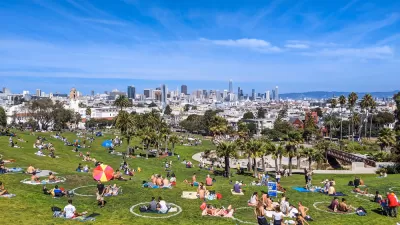Three examples of problem solving and "catalytic action" can help San Diego with its I.D.E.A. District, writes former SPUR director Jim Chappell.
In the East Village area of San Diego, some property owners have a "big idea" for a creative and high tech incubator district. In fact, they're calling it the I.D.E.A. District. I.D.E.A. stands for Innovation Design Education Arts. The East Village has seen some tremendous investment and redevelopment in the past two decades, but pockets of the area continue to lag.
This summer, the San Diego Architectural Foundation held a series of workshops culminating in a panel discussion, titled Context2 - What's the Big Idea? Jim Chappell, former Director of the San Francisco Planning and Urban Research Association (SPUR) was one of the panelists. In an article just published, he recaps his presentation. He gives three examples in San Francisco where, despite best laid plans, revitalization did not occur until an area presented a solution to a pressing problem. He called this "catalytic action." The examples Chappell provided as examples:
Yerba Buena Gardens
Despite the construction of the convention center, this area of SOMA remained essentially a desert until the San Francisco Museum of Modern Art, in need of a new home, took advantage of redevelopment offerings and relocated there.
Mission Bay
Multiple plans for the former rail freight yard land in SOMA owned by Catellus were mired when Mayor Willie Brown, hoping to prevent UCSF Medical School from relocating outside of the city, convinced Catellus to donate 30 acres of its 300 acres to UCSF for a new medical school. The school was built, which catalyzed other related development in the area.
"Twitter Zone"
San Francisco's Central Market neighborhood remained seedy despite several efforts and high expectations for revitalization. In 2011, Twitter was considering relocating outside of the City due to San Francisco’s 1.5% payroll tax. Chappell explains what happened next:
[T]he San Francisco Supervisors passed the Central Market Payroll Tax Exclusion, more popularly known as the "Twitter Tax Break." It’s a simple law that is basically a tax holiday until 2018 within a prescribed Central Market Area. No Redevelopment Area; no Comprehensive Plan; not even a General Plan. Just a tax law.
Under the law, a business pays 1½% payroll tax on the lesser of its payroll its first year in business or its actual payroll. It does not have to pay tax on additional payroll (including those stock options) for six years. This exclusion expires in 2018 (eight years from passage) by which time San Francisco’s payroll tax will be completely replaced by a gross receipts tax.
As a result, Twitter stayed in San Francisco, and numerous other business moved into the Central Market area, accompanied by residential development and restoration of historic buildings.
Chappell's message to San Diego: while catalytic redevelopment can be unpredictable, posture the I.D.E.A. District to solve a problem. In this post-redevelopment California, consider using the Enhanced Infrastructure Financing District law, effective January 1, 2015, to help make the area a problem solver.
FULL STORY: Setting the I.D.E.A. District Apart

Alabama: Trump Terminates Settlements for Black Communities Harmed By Raw Sewage
Trump deemed the landmark civil rights agreement “illegal DEI and environmental justice policy.”

Planetizen Federal Action Tracker
A weekly monitor of how Trump’s orders and actions are impacting planners and planning in America.

The 120 Year Old Tiny Home Villages That Sheltered San Francisco’s Earthquake Refugees
More than a century ago, San Francisco mobilized to house thousands of residents displaced by the 1906 earthquake. Could their strategy offer a model for the present?

High-Speed Rail Tracker
Smart Cities Dive follows high-speed rail developments around the country

Ken Jennings Launches Transit Web Series
The Jeopardy champ wants you to ride public transit.

BLM To Rescind Public Lands Rule
The change will downgrade conservation, once again putting federal land at risk for mining and other extractive uses.
Urban Design for Planners 1: Software Tools
This six-course series explores essential urban design concepts using open source software and equips planners with the tools they need to participate fully in the urban design process.
Planning for Universal Design
Learn the tools for implementing Universal Design in planning regulations.
Clanton & Associates, Inc.
Jessamine County Fiscal Court
Institute for Housing and Urban Development Studies (IHS)
City of Grandview
Harvard GSD Executive Education
Toledo-Lucas County Plan Commissions
Salt Lake City
NYU Wagner Graduate School of Public Service





























